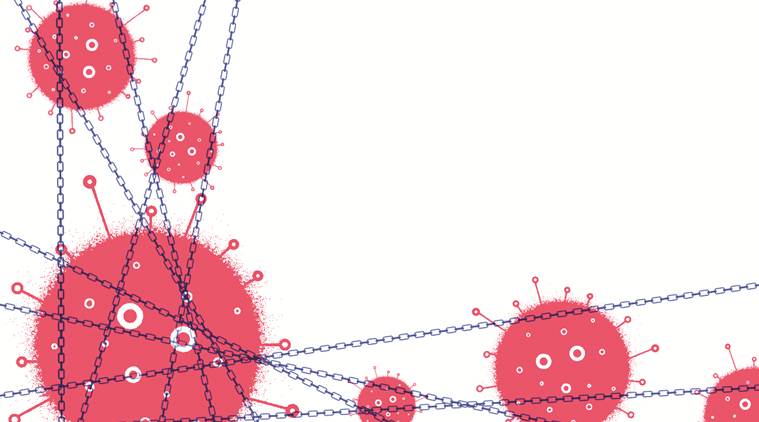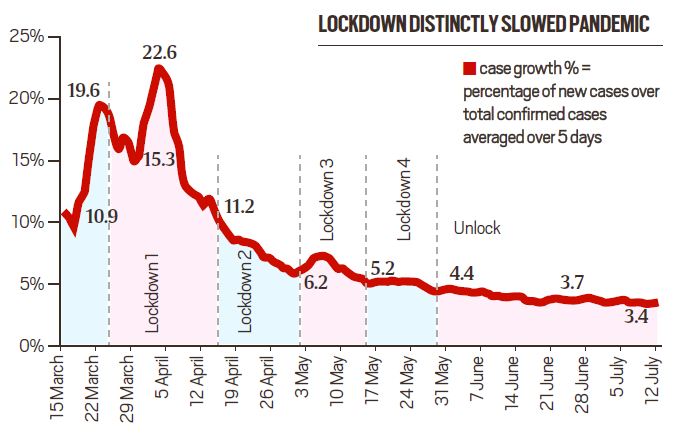It decelerated the pandemic, averted lakhs of cases, saved thousands of lives. The time it provided has been utilised effectively to strengthen the health system.
The first case of COVID-19 in India was reported on January 30. For the next six weeks, aggressive contact tracing and containment measures kept the numbers minimal. However, by the third week of March, it became apparent to experts that the outbreak was entering the exponential phase. The growth rate of new cases had increased by nearly 80 per cent in just over a week preceding March 22, from 10.9 per cent to 19.6 per cent (figure). The doubling time of cases at just over three days was pointing toward an imminent trajectory of an overwhelming caseload and excessive mortality, experienced by the US and many European nations.
The nationwide lockdown announced by the prime minister on March 24, based on this assessment, was a necessary intervention to quell the transmission chain of the virus and to gain time for a high level of preparedness. The unanimous support of the states has been critical in making this measure effective and successful.
SARS-COV-2, a respiratory virus, generally spreads by respiratory and salivary droplets within close physical proximity. There is neither a vaccine nor a drug for prevention. While there are several unknowns in dealing with this new disease agent, increasing the physical distance between individuals and decreasing the frequency of person-to-person contact makes it difficult for the virus to spread. This principle underpins the lockdown strategy. It results in suppressing the transmission chain of the virus, thereby decelerating and limiting the spread. In doing so, lives are saved, the infection is controlled and valuable time is gained to strengthen health systems and prepare a fitting response.
The impact of the lockdown on pandemic progression became evident after about 10 days, by the end of the first week of April, as was expected given the infection incubation period. The figure shows that the growth rate of new cases dropped from an unnerving 23 per cent in the first week of April at the cusp of the lockdown-effect period to decline to just over 5 per cent in the next six weeks by mid-May. This translated into increasing the doubling time of cases from 3.4 days at the outset to over 14 days. As a lasting gain of the lockdown, the growth rate continues to be consistently low even in the unlock phase with the doubling time having climbed to 21 days.
Several independent analyses give us a big-picture view of the situation we would have found ourselves in without the lockdown. Some estimates of cases averted run into crores. The Ministry of Statistics and Programme Implementation has estimated that based on a rational model, the lockdown prevented as many as 14-29 lakh COVID-19 cases and 37,000 to 78,000 deaths (with point estimates of 20 lakh and 54,000, respectively) by mid-May. Remember, even in mid-July, we have yet to reach such a high burden, and this could have been a grim reality in mid-May.
The lockdown has kept the outbreak geographically contained. Even today, only 13 states make up 90 per cent active cases, the others together have 10 per cent active cases. Nearly half of our total cases and 65 per cent deaths are confined to just 10 cities. In the media din, it escapes notice that the vast population of our nation has low or negligible infection prevalence. Notwithstanding the challenges in containing the disease in metros and large cities, the fact remains that overall, the nation has ensured that the pandemic remains manageable so far. Yes, the number of confirmed cases is rising, but on a much lower trajectory than the pre-lockdown curve. Most significantly, the case fatality rate has been progressively declining. India’s health teams are delivering better and better outcomes.
Thanks to the lockdown decision, the total burden of confirmed cases and deaths is among the lowest in the world despite our large and dense population. Six months into the pandemic, we have had about 12 lakh cumulative cases and 27,000 deaths. In contrast, with almost an equivalent combined population, Europe (740 million) plus North America (580 million) together have had 72 lakh cases, and about 4 lakh deaths despite having stronger health systems. So far, we have 811 total confirmed cases per 10 lakh against the world average of 1,881 (USA 11,774, Brazil 9,876, Spain 6,573, UK 4,341, Italy 4,043, France 2,676). Likewise, total deaths per 10 lakh in the country are just 20 compared to the global mean of 78 (UK 667, Spain 608, Italy 580, France 462, USA 433, Brazil 374). We continue to reap the results of the effective reduction in case growth due to the suppression of virus transmission that was achieved during the lockdown (figure).
Besides, the lockdown provided an opportunity to ensure all-round preparedness to face the disease. In the first two months of the lockdown, states readied 3.2 lakh COVID-specific hospital beds along with additional 6.5 lakh beds for suspected and mild cases. In the same period, the testing number reached 30 lakh from a mere 20,000. An entirely new industry to manufacture PPEs was built in a matter of weeks. The country experienced a game-changing moment for telemedicine. The most important gain of the lockdown was the behaviour change in the people. Wearing masks, do gaz ki doori and hand hygiene became widely embraced as the “new normal”.
In this pandemic, each day counts because we learn more about this virus every day and we get better at saving lives. The window provided by the lockdown has also taken us closer to a more informed treatment, better drugs and even vaccines. Two indigenous vaccines have entered human trials and emergency use has been authorised for a few therapeutic modalities.
A lockdown is a very difficult choice for any nation to make. It has huge economic and social costs. However, during the COVID-19 pandemic, this option had to be exercised by many countries to save lives and restore people’s confidence in the face of an emergent catastrophe. At end-April, half a billion people were under lockdown — imposed by most countries in Europe and Latin America. Earlier in the same month, almost 300 million people in the US were in some form of lockdown. Most of these countries resorted to lockdowns at a stage when the epidemic was already overpowering, their health system capacities were close to being exhausted and the burden of deaths was already overwhelming. The lockdown had become an inevitable compulsion for them.
In contrast, India has been proactive and pre-emptive in its approach and took this measure at a point when the size of the outbreak was manageable and deaths were low. If it was not for the lockdown, by now, the scale of the pandemic would have been astronomically larger with devastating consequences. The lockdown effectively decelerated the pandemic, averted lakhs of cases and saved thousands of lives. The time it provided has been utilised effectively to strengthen the health system. Challenges lie ahead, but a timely lockdown gave India an edge in the war against the pandemic.
The writer is Member (Health), NITI Aayog. Views are personal
? The Indian Express is now on Telegram. Click here to join our channel (@indianexpress) and stay updated with the latest headlines
For all the latest Opinion News, download Indian Express App.
Source: Read Full Article






